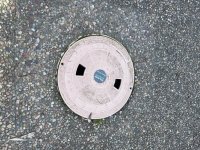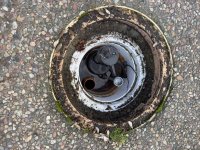- I lowered the pool's level a bit, so there is more head-room between the auto-fill's target level and the outflow pipe.
The level of the pool should be determined by the skimmer opening (more than anything else), and not what solves an auto-fill issue. So let's start there. While the water level can vary a bit, the ideal level is halfway up the skimmer opening. If you're there, then you're golden. If not, then you might consider adjusting the overflow pipe, not the pool's level.
Can you describe your "outflow pipe?" Is it a vertical pipe in the auto-fill well? If so, then what you have is more accurately called an auto-
leveling system (not just auto-fill). Assuming that's what you have, both the pool level and the overflow threshold are adjustable. I take it you know how to adjust the auto-fill level. You adjust the overflow threshold by shortening or lengthening the overflow pipe. You can do this in several ways. The simplest way is to pull out the pipe (it is likely just friction fit into a fitting at the bottom of the well). It should just wiggle free. GENTLY! You do NOT want to compromise the fitting at the bottom of the well. If it doesn't come free easily, don't mess with it.
If it does come free, you would replace it with a slightly longer pipe. It should be a standard size of PVC. You would, of course, already have this new pipe on hand. You pull out the old one, cut the new one to length, and wiggle in the new one. Keep in mind the pool will be draining once you pull the old pipe out, so be ready with the new one and work quickly.
A simpler method, which you would use if the old one doesn't wiggle free, is to just slide a PVC coupler over the existing pipe. The only problem with this MO is that it won't be a granular adjustment. It'll add about an inch to the overflow threshold, and not very adjustable. If you go this route, and find the coupler adds too much height to the overflow pipe, then use a hack saw to cut the coupler. In this way, you can add just about any length to the existing pipe.
If this doesn't sound like what you have, then "never mind." Or if your water level is currently acceptable, or you just want to leave well enough alone (always a good way to go), then consider it solved.
All that said, it doesn't really explain where all the water was going, how it was leaving the pool. Unless what you've discovered was that, for whatever reason, your auto-fill valve was just pumping water into your overflow pipe, and sending all that water into your garden (or wherever it exits).
I've had that problem before myself. I took precautions against that happening again (at least happening without me knowing about it). I exposed and extended the end of the overflow pipe (it was buried in brush in the garden), and I can now see it, to keep an eye on it. And then I configured a cam so that I could watch it whenever, from wherever. If I see water coming out of that end of the pipe during a rain, then that's expected. Otherwise, if I see it draining when it shouldn't be, I can assume my auto-leveling system is malfunctioning in some way.


I couldn't quite get the angle on the end of the pipe with my cam, so I solved that with a small mirror. The second pic is a still from my pool cam, which is PTZ, so I can check on several aspects of my pool, remotely. This can be seen as extravagant, sure, but it's peace of mind while I'm away, which is often these days.
The pic I posted previously, of my water level ruler, is also a still from my pool cam. I mounted that ruler permanently (which got a few snickers here on the forum), and it
is pretty goofy, but I use it almost every day. I can monitor my pool's water level to 1/16 of an inch, from anywhere on the planet. I can hop back and forth between my cam's "Level" and "Overflow" presets, and verify all is well with my auto-leveler.
A story for another day: I have a motorized valve, that is scheduled by my pool automation system, that is inline with my auto-fill valve supply. It's for a purpose other than what we're talking about here, but I can use it to shut down my auto-fill valve remotely if I have to (like if I spotted my overflow pipe draining water in the middle of summer, while I was away).

















